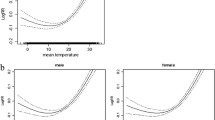Abstract
Few previous studies have examined the association between temperature and renal colic in developing regions, especially in China, the largest developing country in the world. We collected daily emergency ambulance dispatches (EADs) for renal colic from Guangzhou Emergency Center from 1 January 2008 to 31 December 2012. We used a distributed-lag nonlinear model in addition to the over-dispersed generalized additive model to investigate the association between daily ambient temperature and renal colic incidence after controlling for seasonality, humidity, public holidays, and day of the week. We identified 3158 EADs for renal colic during the study period. This exposure-response curve was almost flat when the temperature was low and moderate and elevated when the temperature increased over 21 °C. For heat-related effects, the significant risk occurred on the concurrent day and diminished until lag day 7. The cumulative relative risk of hot temperatures (90th percentile) and extremely hot temperatures (99th percentile) over lag days 0–7 was 1.92 (95 % confidence interval, 1.21, 3.05) and 2.45 (95 % confidence interval, 1.50, 3.99) compared with the reference temperature of 21 °C. This time-series analysis in Guangzhou, China, suggested a nonlinear and lagged association between high outdoor temperatures and daily EADs for renal colic. Our findings might have important public health significance to prevent renal colic.



Similar content being viewed by others
References
Amato M, Lusini M, Nelli F (2004) Epidemiology of nephrolithiasis today. Urol Int 72(Suppl. 1):1–5
Bartoletti R, Cai T, Mondaini N, Melone F, Travaglini F, Carini M, Rizzo M (2007) Epidemiology and risk factors in urolithiasis. Urol Int 79(Suppl. 1):3–7
Boscolo-Berto R, Dal Moro F, Abate A, Arandjelovic G, Tosato F, Bassi P (2008) Do weather conditions influence the onset of renal colic? A novel approach to analysis. Urol Int 80(1):19–25
Brikowski TH, Lotan Y, Pearle MS (2008) Climate-related increase in the prevalence of urolithiasis in the United States. Proc Natl Acad Sci U S A 105(28):9841–9846
Bultitude M, Rees J (2012) Management of renal colic. Br Med J 345:e5499
Chauhan V, Eskin B, Allegra JR, Cochrane DG (2004) Effect of season, age, and gender on renal colic incidence. The American Journal of Emergency Medicine 22(7):560–563
Chen Y-K, Lin H-C, Chen C-S, Yeh S-D (2008) Seasonal variations in urinary calculi attacks and their association with climate: a population based study. J Urol 179(2):564–569
Cupisti A, Pasquali E, Lusso S, Carlino F, Orsitto E, Melandri R (2008) Renal colic in Pisa emergency department: epidemiology, diagnostics and treatment patterns. Intern Emerg Med 3(3):241–244
Fakheri RJ, Goldfarb DS (2011) Ambient temperature as a contributor to kidney stone formation: implications of global warming. Kidney Int 79(11):1178–1185
Gasparrini A (2011) Distributed lag linear and non-linear models in R: the package dlnm. J Stat Softw 43(8):1
Gasparrini A, Guo Y, Hashizume M, Lavigne E, Zanobetti A, Schwartz J, Tobias A, Tong S, Rocklov J, Forsberg B, Leone M, De Sario M, Bell ML, Guo YL, Wu CF, Kan H, Yi SM, de Sousa Zanotti Stagliorio Coelho M, Saldiva PH, Honda Y, Kim H, Armstrong B (2015) Mortality risk attributable to high and low ambient temperature: a multicountry observational study. Lancet 386(9991):369–375
Guo Y, Gasparrini A, Armstrong B, Li S, Tawatsupa B, Tobias A, Lavigne E, de Sousa Zanotti Stagliorio Coelho M, Leone M, Pan X, Tong S, Tian L, Kim H, Hashizume M, Honda Y, Guo YL, Wu CF, Punnasiri K, Yi SM, Michelozzi P, Saldiva PH, Williams G (2014) Global variation in the effects of ambient temperature on mortality: a systematic evaluation. Epidemiology 25(6):781–789
Ma W, Chen R, Kan H (2014) Temperature-related mortality in 17 large Chinese cities: how heat and cold affect mortality in China. Environ Res 134:127–133
Noble VE, Brown DFM (2004) Renal ultrasound. Emerg Med Clin N Am 22(3):641–659
Parks JH, Barsky R, Coe FL (2003) Gender differences in seasonal variation of urine stone risk factors. J Urol 170(2 Pt 1):384–388
Pincus S, MacBean C, Taylor D (2010) The effects of temperature, age and sex on presentations of renal colic in melbourne, Australia. European Journal of Emergency Medicine 17(6):328–331
Shoag J, Tasian GE, Goldfarb DS, Eisner BH (2015) The new epidemiology of nephrolithiasis. Advances in Chronic kidney Disease 22(4):273–278
Solomon S, Qin D, Manning M, Chen Z, Marquis M, Averyt KB, Tignor M, Miller HL (2007) Climate change 2007-the physical science basis: working group I contribution to the fourth assessment report of the IPCC. Cambridge University Press, Cambridge, United Kingdom and New York, NY, USA
Tasian GE, Pulido JE, Gasparrini A, Saigal CS, Horton BP, Landis JR, Madison R, Keren R, Urologic Diseases in America Project (2014) Daily mean temperature and clinical kidney stone presentation in five U.S. metropolitan areas: a time-series analysis. Environ Health Perspect 122(10):1081–1087
Zeger SL, Thomas D, Dominici F, Samet JM, Schwartz J, Dockery D, Cohen A (2000) Exposure measurement error in time-series studies of air pollution: concepts and consequences. Environ Health Perspect 108(5):419–426
Acknowledgments
The study was supported by the Public Welfare Research Program of National Health and Family Planning Commission of China (201502003), National Natural Science Foundation of China (81222036), China Medical Board Collaborating Program (13-152), and Cyrus Tang Foundation (CTF-FD2014001).
Author information
Authors and Affiliations
Corresponding authors
Ethics declarations
Conflict of interest
The authors declare that they have no competing interests.
Additional information
Changyuan Yang and Xinyu Chen contributed equally to this work.
Rights and permissions
About this article
Cite this article
Yang, C., Chen, X., Chen, R. et al. Daily ambient temperature and renal colic incidence in Guangzhou, China: a time-series analysis. Int J Biometeorol 60, 1135–1142 (2016). https://doi.org/10.1007/s00484-015-1106-7
Received:
Revised:
Accepted:
Published:
Issue Date:
DOI: https://doi.org/10.1007/s00484-015-1106-7




